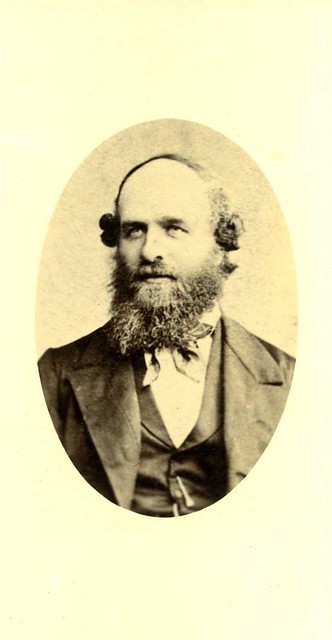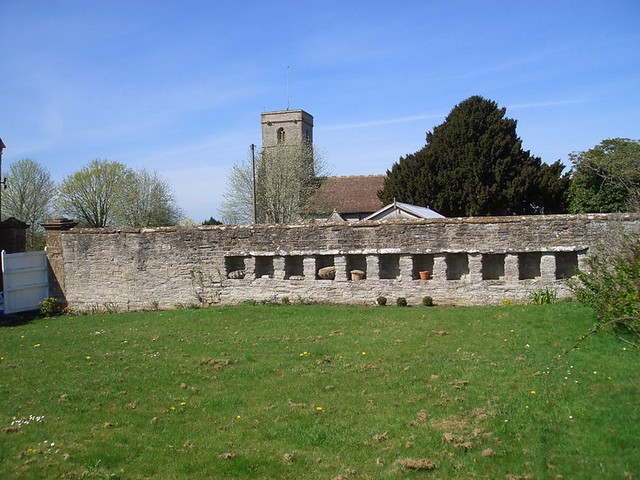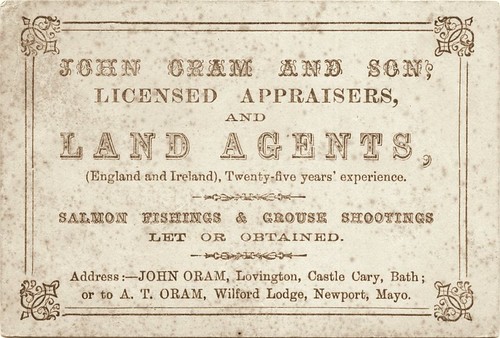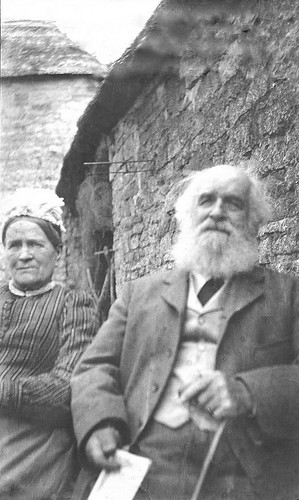Born: 27 Nov 1824 and baptised on 19 Dec 1824 at Castle Cary, Somerset, England
Parents: James Oram 1774-1839 and Susannah Bartlett 1782-1838
Siblings: William Oram c1810-1873 , Mary Oram c1813-1888 , Susannah Oram 1817-1899, Elizabeth Oram c1818 – 1878, Sarah Oram 1820-1869
Married: Jane Talbott 1829-1906 18 Jul 1847 at Rimpton, Somerset, England
Offspring:
- John Samuel Oram 1847 – 1913
- Jane Charity Oram 1849 – 1945
- Emily Talbott Oram 1851-1852
- Arthur Talbott Oram 1853 – 1919
- Charles Somerset Oram 1855 – 1856
- James Henry Oram 1857 – 1918
- Frances Albert Oram 1858 – 1859
- Alfred William Oram 1861 – 1942
- Caroline Susannah Oram 1863 – 1947
- Emma Agnes Oram 1865 – 1955
- George Oram 1866-1866
- Lily Louisa Oram 1869 – 1952
- Edith Mabel Oram 1870 – 1951
- Letitia Kathleen Oram 1872 – 1942
Lived in: Castle Cary and Weston Bampfylde, Somerset; Stockton, Wiltshire; Manston and Iwerne Minster, Dorset, England; Burrishoole, Newport, Co Mayo, Ireland; Clinsfold, Slinfold, Sussex, England; Wilford Lodge, Newport, Co Mayo, Ireland; Lovington and Little Weston, Somerset, England.
Died: 14 Apr 1907 at Little Weston, Somerset, England
_____________________________________________________
Daphne Oram’s entry for the ‘Oram Family Saga’ following her research into the family’s oral history in the 1960s.
_____________________________________________________
John Oram was the youngest son of James and Susannah Oram of Weston Bampfylde, Somerset. Little is known of his parents, except they were married and buried at South Barrow and that in later life they ran a farm near the Church at Weston Bampfylde. So far we have not found where they lived when the children were born. We know that John rode to school each day in Castle Cary on his horse. Family tradition has it that later on he went to Sherborne School.
Unfortunately, when John was 14, his mother died and his father the following year. We understand his eldest brother, William, took over the farm, but did not make a success of it; so two years later John went to live in Sparkford with his sister, Mary who was married to James Hockey, a butcher in that village.
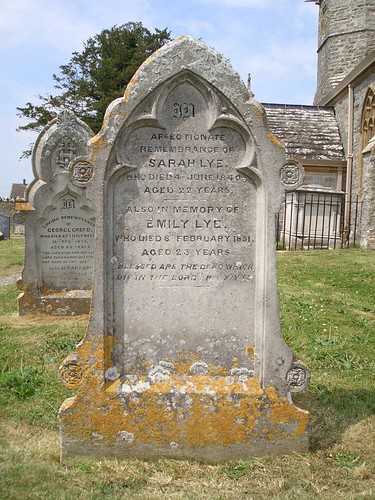 Whilst John was in his teens, he fell madly in love with a local girl named Emily Lye. She was the youngest daughter of Mr. Lye of “Avalon”, Little Weston (on a window pane in this house the girls scratched their names “Sarah July 8th 1830, Susan 1829, Emily”) and Sarah and Emily’s marble gravestone is in Weston Bampfylde churchyard recording that they died aged 22 years & 20 years respectively.
Whilst John was in his teens, he fell madly in love with a local girl named Emily Lye. She was the youngest daughter of Mr. Lye of “Avalon”, Little Weston (on a window pane in this house the girls scratched their names “Sarah July 8th 1830, Susan 1829, Emily”) and Sarah and Emily’s marble gravestone is in Weston Bampfylde churchyard recording that they died aged 22 years & 20 years respectively.
John must have been devastated by Emily’s early death for he remembered her all the rest of his life. His third daughter was called Emily, but she only lived 5 months – then many years later, he was staying at Wilford when Arthur & Catherine’s twins were born, so he asked if this granddaughter could be called Emily. He remembered this Emily in his will, leaving her £15.
When he finally retired, he went to live in the home of his first love. He recorded in his diary on September 17th 1892 “Left Lovington and came to live at Weston – Mr. Lye’s old house!”
Every Sunday morning John lingered by Emily Lye’s grave to the last possible moment before going into the church where he was churchwarden. When he was quite an old man he told his next-door neighbour, Mrs. Perry, that a few days previously he had seen Emily quite plainly as he was driving along the road. She had looked at him over the gate.
This early love of John’s for Emily was always an open secret and must have been well understood and accepted by his wife, Jane. His marriage to Jane Talbot of Sparkford remained one of steady affection and mutual dependence through their 59 years of married life – but their daughter, Edith, always maintained that this caused Jane considerable uneasiness. It certainly cannot have been easy to go and live in the house of one’s husband’s first love as Jane did when they retired to Little Weston.
As a young man John was pupiled to a farmer called Chandler in the Sparkford area where he learnt dairy and cheese farming. It was during his time here that on Thursday January 1st 1846 he attended the Sparkford Annual Ball at Sparkford Inn. We have the invitation sent to him. Gentlemen’s tickets were 3s. 6d. Ladies tickets 2s. 6d. A family of four, 10s. It also states that “an efficient band will be in attendance”. One wonders why he kept this invitation all those years and which young lady made that New Year’s Party such a memorable occasion. Soon after he married he moved to a farm owned by the Wyndham family at Stockton in the Wylye Valley. Here a Mr. Yeatman-Biggs taught John corn-growing and sheep rearing. Whilst they lived here John Samuel was born on November 24th 1847 and the family obviously spent Christmas with Jane’s family in Sparkford, for on Boxing Day 1847, John Samuel was christened at Sparkford church.
About 1848 the family moved to Manston, near Iwerne Minster, Dorset, where their eldest daughter, Jane, was born. During this time he was persuaded by Capt. Wyndham to go over to Co. Mayo and look after the Wyndham estates there. So in 1853 Jane returned to her parents to await the birth of their son, Arthur; whilst John set out for Mayo with the estate carpenter, Watt Spicer. At first they lived in a tower on the estate at Maryland House, whilst they started to build a typical English farmstead at Burrishoole, starting first with the sheds for the animals, then a house for himself. In his diary, he wrote on January 18th 1855 “Left Maryland and came to Carraunboy to live and very glad to make the change.” When this house was complete, they built a new lodge for the Wyndham Family.
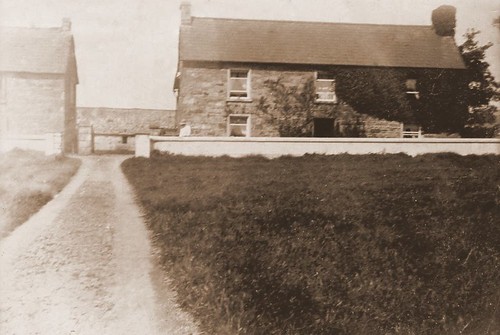
Burrishoole
He also ran estates for Mrs. Grant at Ballycroy and several others. He rented land near Achill Island for his own use. His grandsons, Arthur and James say that whenever their grandfather passed one mountain near Achill, he always sighed and announced that he had lost an awful lot of money on that mountain! – sheep just vanished and they never managed to catch the thieves however hard they tried.
Whilst managing these estates he started a salmon hatchery which is, today, run by the Eire Government. The tale was often told in the family how he carried up the first baby salmon to the hatchery in buckets slung below the cart so that they did not get too hot; and how concerned he was to get them up there safe and sound before they all died. He attended meetings of the Fishery Commissioners at Castlebar and had broad interests in local river and off-shore fishing.
 Part of John’s salary was paid in so many salmon a month – so it often appeared on the menu. John arranged things so that the whole household was as self-supporting as possible – a philosophy he propounded, in a booklet he wrote in 1865 called “Essay on the cultivation and Management of Small Farms“, Price 6d. or £2 per 100. A shorter version of this essay had appeared in the Irish Farmers Gazerte – John had been asked for more copies so this fuller essay was finally printed in booklet form. His theory was one of a 5 & 6 year rotation of crops, instead of the usual potatoes then grass system. He suggested first using oats, then flax and potatoes, then barley, next turnips, cabbage, mangels , carrots and parsnips, then hay and finally pasture. He assured his readers that with 6 acres using this method a farmer could have a net return of £34 8s 0p. So long as he weeded well. In this booklet he also stated his conviction that the Irish peasant farmer was not irreclaimable as so many folks believed in those days. However, on April 18th 1855, after coping with a salmon fishing trip when the crew got drunk, he recorded in his diary “Whisky and Popery the two curses of Ireland – the land cannot bear them both.” It is also interesting to note that on December 2nd 1854 John records “sold oats, the first in Ireland 7/7 per cwt.” Also around that time he was sending 80 lambs to Dublin On July 30th 1855 Lambs in Liverpool market were costing 11/6 — 15/6. In 1866 he sent 138 lambs to England. He had a lime kiln on the estate and kept to the advice in his booklet for the records “Cleaning flax seed” “Lifting turnips” “Sowing beans & potatoes” “Finished storing mangel” “Ploughing for peas etc.” “Making straw ropes etc.”
Part of John’s salary was paid in so many salmon a month – so it often appeared on the menu. John arranged things so that the whole household was as self-supporting as possible – a philosophy he propounded, in a booklet he wrote in 1865 called “Essay on the cultivation and Management of Small Farms“, Price 6d. or £2 per 100. A shorter version of this essay had appeared in the Irish Farmers Gazerte – John had been asked for more copies so this fuller essay was finally printed in booklet form. His theory was one of a 5 & 6 year rotation of crops, instead of the usual potatoes then grass system. He suggested first using oats, then flax and potatoes, then barley, next turnips, cabbage, mangels , carrots and parsnips, then hay and finally pasture. He assured his readers that with 6 acres using this method a farmer could have a net return of £34 8s 0p. So long as he weeded well. In this booklet he also stated his conviction that the Irish peasant farmer was not irreclaimable as so many folks believed in those days. However, on April 18th 1855, after coping with a salmon fishing trip when the crew got drunk, he recorded in his diary “Whisky and Popery the two curses of Ireland – the land cannot bear them both.” It is also interesting to note that on December 2nd 1854 John records “sold oats, the first in Ireland 7/7 per cwt.” Also around that time he was sending 80 lambs to Dublin On July 30th 1855 Lambs in Liverpool market were costing 11/6 — 15/6. In 1866 he sent 138 lambs to England. He had a lime kiln on the estate and kept to the advice in his booklet for the records “Cleaning flax seed” “Lifting turnips” “Sowing beans & potatoes” “Finished storing mangel” “Ploughing for peas etc.” “Making straw ropes etc.”
They had many Scots and English friends who were stewards or agents for local estates. The Hopes next door at Maryland, the Hunters of Newfield House, The Smiths who were agents for the O’Donnells of Newport House and the McAdams who lived at Abbeyville.
As representative of the landowners, John and Jane were expected to attend all weddings and wakes. As his wife was often in poor health, due to her numerous confinements, Jane Charity, their eldest daughter, took her place instead. She had strange tales to tell of nights spent in cabins on these social occasions.
 John visited England several times making fantastic tours, as one can see from this itinerary in 1866.
John visited England several times making fantastic tours, as one can see from this itinerary in 1866.
Jan.12 To Dublin and embarked for Holyhead.
13 Stratford, Birmingham, Bristol.
14 Bristol to Sparkford, Barrow & Babcary.
15 At Babcary & Barrow.
16 From Sparkford to Wellington via Yeovil.
17 Valuing Stallards Farm, Wellington valuing timber, etc.
18 Finished at Wellington – valuing at Hill Farrance and Bathpool and back to Taunton.
19 From Taunton to Sparkford via Yeovil and to Babcary and back to Barrow and Sparkford.
20 Sparkford to Charlton, Sherbourne and Gillingham.
21 Gillingham to Charlton – Church p.m.
22 Charlton to Sparkford and onto Swindon.
23 Swindon to London and onto Woolwich.
24 Woolwich to London. Met Capt. Goff and Mr. Bushby.
25 London to Holyhead and embarked for Dublin.
26 Arrived at Dublin – saw model farm etc. at Glasnevin.
27 Left Dublin and got home safe once more thank God.
(I consider this a fantastic journey and would not find it easy to accomplish even today with a motor car – Railways in 1866 must have been efficient, reliable and on time – and John’s constitution remarkable!)
But a great shadow hung over everything -the continuous threat on the lives of the Scots and English stewards and agents by the various agrarian secret societies. On November 8th 1854 John received a threatening letter and on November 22nd 1854 John Reddy, the Head Constable of Newport was offering a reward of 30 pounds, saying “Whereas on the 8th instant, a Rockite letter, threatening Mr. George Hope and Mr. John Oram, Land Stewards, was found at Newfield in the Barony of Burrishoole, County Mayo.
I hereby offer a reward of 30 pounds to any person within 6 months from the date hereof, giving such information as shall lead to the Arrest of the party concerned in writing or sending the letter in question. Payable on Conviction.”
Prof. Moody of Trinity College Dublin informs me that “Rockite” was a name used to describe one of the many agrarian secret societies that flourished in Ireland in the 19th century. A Rockite letter was a method of seeking to intimidate a landlord or someone employed by or co-operating with a landlord, whom the Rockites had marked out for hostile attention.
Reflecting on this, perhaps one can imagine a little the constant strain on the Oram Family – on this particular occasion the police were seriously dealing with the problem for 30 pounds was no mean reward in those days as it was roughly the annual income of a peasant farmer in a good year. John records that one of the farmhands called Strickland “requests to return to England” and “Hope swears he is in dread of Matheson”. Later, “Mr. Hope’s mare said to be maliciously killed”. In August 1870 on Sunday 28th “Mr. Saunders’ guns taken out of Burrishoole House by villains.” Even the womenfolk were not safe as on December 31st 1869 Miss Gardner of Ballycastle was shot at and wounded. One wonders also what were the stories behind the brief entries “Spicer in difficulties” and “Susan Nixon’s Funeral – Great Riot – the priest and a mob burying the corpse by force.” Another hazard was Cholera which was rife in Westport in 1864.
On August 29th 1869 John was awakened by gravel being thrown up at the window – below was Mr. Hunter’s man shouting “Mr. Oram, Mr. Oram, Mr. Hunter’s dead: They shot him as he rode home from church.” John dressed immediately, mounted his horse and went to do all he could for Mr. Hunter’s widow. After the incident, she had taken over the reins from her dead husband and driven home. Simon Hunter, the young son in the back of the trap never fully recovered, and on the following Tuesday at the Inquest it was recorded as “wilful Murder against persons unknown.” (2013 note: an English journalist’s account of this incident written in 1881 and compare with part of an article in the 19 August 1950 edition of The Mayo News) Another time John was called upon to help the Smith family after another shooting.
In November 1869 John again received threatening letters. However, it was not until October 2nd 1872 that he recorded “Paid waterkeepers – shot at returning to Mulranny a mile beyond Dughill. Ball went through clothes, but by the good providence of God I escaped”. On the 3rd “Went to point out place to County Inspector” 4th “To Westport and Clogher -Great congratulations on my escape” and on Sunday 6th “Church A.M.C. Public thanks to Almighty God for escape from the assassin.”

Cutting of Newspaper article found in back of Samuel Talbott’s (Jane’s father) Bible
The local tenant farmers were so shocked when they heard of this that all 44 of them on one of the estates signed a manifesto declaring in October 1872 “We the undersigned tenant farmers on Mrs. Grant’s estate in Ballycroy, desire to express our abhorence of the atrocious and dastardly attempt lately made to assassinate her excellent agent, Mr. John Oram of Burrishoole, and we hereby pledge ourselves severally and collectively to lose no opportunity of bringing the would-be murderer to public justice.”
The local Ballina Herald recording this manifesto said “This is something new in Co. Mayo and is an omen for good. The outspoken manly conduct of Mrs. Grant’s tenants deserves to be held up to the emulation of the tenantry in all districts where agrarian crime is rife.” How grateful John must have been to have occasionally been able to report, as in December 1865 “Walking among tenants who are more comfortable than for some years past.”
Despite this moral support, John became increasingly irked by having two policemen to accompany him night and day. (All local stewards and agents were being guarded in this way – which meant that if three of them met, there were six policemen to guard them!!) Also the worry of all this was having an adverse effect on Jane’s health. In his end of year summary for 1872 he again refers to this affair and ends up “in consequence of this I surrendered Mr. Vaughan’s Agency and tried to get a farm in England, but have not yet succeeded.” — So he began to listen to Mr. Simes, an English landowner from Strood Park near Horsham, who came over each summer for his holiday on Rockfleet Bay, who persuaded him to lease one of his farms called Clinsfold near Slinfold Sussex. An offer he accepted on January 11th 1873. One can imagine the relief with which the family moved to Sussex, leaving Arthur to run the Irish estates with the help of William Rose.
Although the farmhouse at Clinsfold was roomy and they lived without the threat of an assassin’s bullet, John was not happy there. He suffered two bad harvests and did not like the confined life of a farmer, after his freer life as an agent.
So in 1877, the family returned to Ireland, this time to live at Wilford Lodge, overlooking Rockfleet Bay. By this time all the boys had left home except Arthur who continued to run the various estates.
In 1880 Jane’s cousin, Marshall Bartlett, visited his Oram cousins and he realised that they would all be so much happier back in Somerset. So on his return he found that a new tenant was required by the Church Commissioners to run Charity Farm, Lovington, Somerset. So John, Jane and the girls gratefully moved back to England, leaving Arthur and his bride, Catherine at Wilford.
Charity Farm was obviously a very happy home. Famous even today as it has a “Bee Wall” in the garden.
Each year John had cattle sent from Ireland so he could fatten them on the upper grazing fields at Lovington. His daughter, Edith, was horrified to find in the 1930’s that farm workers’ houses had been built on the best of the farm land.
We also have a business card which shows that John & Arthur co-operated at this time acting as agents for salmon fishing and shooting rights and land valuation both in Somerset and Co. Mayo.
John had not lived long at Lovington before he was appointed a churchwarden. Whilst he had been at Clinsfold he had rated the vicar for his over-fondness for candle burning, and he had not been long at Lovington before something similar happened, involving a picture behind the Altar. John could not reconcile this with his implacable conscience, so he walked over to Wheathill Church each Sunday instead.
John & Jane lived happily and peacefully in Lovington until they retired to Little Weston in September 1892, just after their daughter’s wedding to Alfred Hinxman. It was during this family reunion that his eldest son, John (on a visit from America), discovered how little money his parents had to live on – so he persuaded John to invest his money in John S. Oram Co. in Cleveland, U.S.A. The resultant profits made the last years of John and Jane’s lives that much more easy and comfortable than they would otherwise have been. (This was thanks to his eldest son’s generosity.)
Even when John had officially retired, he still helped to run the Sparkford Estate for the Bennett family and was busy as a churchwarden. (He was elected Parish churchwarden on April 3rd 1893.)
He often sat on the bench in the Perry’s garden next door under the Wellingtonia Pine putting church matters and the world to rights; or driving to the local station in his donkey cart to collect one of his numerous visiting relations. At the time of Edward VII’s coronation he planted a commemorative tree at the main road junction by the station in Sparkford.
To sum up this remarkable man I will quote his grand-daughter Lily Hinxman “Grandfather, John Oram, was upright, fearless, shrewd, able; a man of authority accustomed to being obeyed but unwilling to use force, or carry arms.” A man obviously loved by his family, friends and employees.
Each year in his diaries John made a summary on December 31st. Typical of this was the year that he retired.
“1892 was a very trying season for farmers. The Spring was cold and backward. The Summer dry – hay a very short crop while wheat fell to the lowest point since records were kept. 26/- per quarter – cattle were very low – quite unsaleable. Apples a heavy crop in some places – none in others – a hard frost, with ice quite thick on 15th June – an astonishing year on the whole – To me it is so on account of our family gathering in August and my giving up business and coming to live at Weston Bampfylde in September – having left it in August 1841. The Autumn was fine, closing the year with a week of hard frost.”
(As yet I have not discovered John’s date of birth – nor where he was born – nor where he married. The latter mystifies me as all Jane’s brothers and sisters weddings are recorded in Sparkford Church registers. Although John & Jane had two of their children christened in that Church ….. Ed.)
______________________________________________________
Photographs of John Oram 1824 – 1907
______________________________________________________
Supporting Documents for John and Jane

